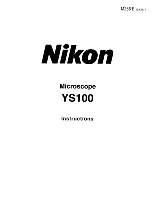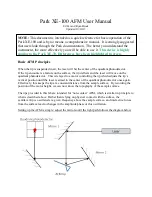
12
13
www.barska.com
www.barska.com
Staining Smears
Not all specimens are easily observed in the microscope. Staining specimens
make them easier to see. Staining is not difficult, but it does require care. It is
recommended that you keep paper towels nearby, as the process can be messy.
First, create a fresh smear (you may use shavings from an apple or other piece
of fruit), as described previously. Do not place any water or a cover slip on the
specimen. Set the slide aside to dry, if necessary.
When the slide is dry, use the needle to place one drop of Eosin on the slide.
Eosin Dye will stain your specimen.
Tilt the slide from side to side to spread the stain over the specimen. Remove the
excess fluid to the waste cup. Put down the slide and wait about two minutes.
Caution
To flush away the excess stain and to stop the staining action, hold the slide at
an angle over the waste cup. Using the eyedropper, touch the slide just above
the specimen area and slowly let the water drain into the cup.
With a paper towel, pat the underside of slide dry. Be very careful and try not to
touch the specimen. Allow the specimen to air dry for several minutes.
Some of the specimen will be flushed away, but enough will remain on the slide
to make good observations. To save your slides, follow the pro cedure described
previously.
Note
In order to stain a slide, you will need to prepare the Eosin: Without opening the
container, look closely at the container marked Eosin. You’ll notice a few grains of
‘dust’ at the bottom of the container. These are the grains of Eosin. Remove the
container’s lid fill the container with water. Gently stir the mixture. You have now
prepared the Eosin for use.
A Simple Section Slide
Section slides are extremely thin slices of tissues of skin, leaves, flower stems,
and other materi als. Generally, section slides are very difficult to make without
special equipment and procedures. However, there is one common house hold
item, which can be sectioned without special equipment: the common onion,
made up of layers of tissue.
Peel off the very thinnest layer you can. One that is nearly transparent will make
an ideal section. Insert specimens you wish into the hole of the micro-slicer.
Rotate the knob to cut your specimen into a thin slice, about 1/4 x 114 inch.
Put two drops of Eosin in a collecting vial. Pick up the piece of onion with your
tweezers and place it in the vial.
Wait for one or two minute. Remove the piece from the stain and flush clean
water, holding it with tweezers over the waste cup. Place it on a clean side. To
save your slide, follow the procedure described previously.
Life Under Glass
Fill a wide mouth jar with fresh water. Let it stand for three or four days without
the lid. Then drop a handful of dry grass and a pinch or two of dirt into the jar. Put
the cap on the jar and keep it in a place where it will receive light (but not direct
sunlight).
In about five days, you may examine the water. First make a special slide: Using
a needle or stirring rod, make a ring of petroleum jelly on a clean slide. The ring
should be smaller than a cover slip and be about half as thick as a slide.
Put a drop of water from the jar onto the slide inside the ring. Use the lowest
power of your microscope and write down your observations. Did you detect any
movement in the water? The movement is caused by microscopic animals. Try to
focus on one of the animals- this may not be very easy as a drop of water is like
an ocean to a microscopic creature.
If the animals seem to be moving too fast to study or don’t stay in focus for very
long, soak up a little bit of water with a corner of a paper towel.
Caution
The blade of the micro slicer is very sharp. Handle the micro-slicer with care.
Remember, you can make a specimen slide out of almost any material. When
you are on a playground, at school, in a park, or just sitting around at home,
train yourself to look at all the material around you. Keep an eye out for what
might make a good spec imen and discover the hidden microscopic world that
surrounds us all.
Care
When treated with care, will provide you with years of use and discovery fun.
- Always carry the microscope with two hands, one around its arm and one under
the base.
- Always remove slides from the stage before putting the microscope away.
- Cover the microscope when not in use.
- Do not use anything except lens cleaning tissue to clean the lenses.
- Never touch a slide with the objective lenses of the turret.
- Remove the batteries before storing the microscope for a month or longer.

























